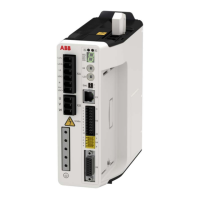172 Resistor braking
Introduction
Each drive has a braking capacity that defines the amount of regenerative energy its
DC bus capacitors can store before the voltage on the capacitors exceeds the drive’s
over-voltage level. In a common DC system, all of the drive’s DC bus capacitors are
connected, so the system braking capacity becomes the sum of all the drives’ braking
capacities. If the total regenerative energy in the system exceeds the system braking
capacity, the excess energy must be diverted into a brake resistor (also known as a
regeneration or ‘regen’ resistor) to be dissipated as heat. The brake resistor can be
connected to one drive in the system, but if that drive’s braking chopper cannot
withstand the total regenerative power in the system, more than one drive must be
fitted with a brake resistor.
System braking capacity
The braking capacity of the drive is calculated from the following formula:
B
dc
= 0.5 x DC bus capacitance x (Brake switching threshold)
2
– ( x Supply voltage)
2
where the Brake switching
threshold is 388 V. This gives the following typical values:
MicroFlex e190
Braking capacity, B
dc
(J)
Model Frame
DC bus
capacitance (μF)
240 V AC supply
01A6-2 A
560 12.5
03A0-2 A
06A0-2 A
1120 25
09A0-2 A

